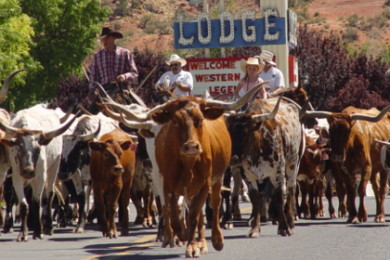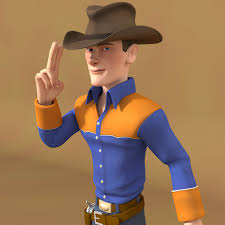 Although Lawyers are supposed to be golfers, because I didn’t do much golfing once I got to Kanab, I didn’t meet many people, including potential clients, on the golf course, and that’s not how I met Kenneth McCoy.
Although Lawyers are supposed to be golfers, because I didn’t do much golfing once I got to Kanab, I didn’t meet many people, including potential clients, on the golf course, and that’s not how I met Kenneth McCoy.
McCoy was a self-described rancher. And given my early naïveté and resurrected redneck leanings, right at first I was quite enthused about having a “rancher” like McCoy as a client. When I first met McCoy, although he had on the standard uniform of boots, jeans and plaid, pearl-snap shirt, he didn’t seem to wear them very comfortably, and unlike Chet Rawlins, he didn’t strike me as being very forked. After announcing that he was a rancher, and telling me in his deep, gravelly smoker’s voice that he owned the best place in Johnson Canyon, McCoy wasted no time telling me exactly how many acres of land and acre feet of water he owned — undoubtedly to impress me (something most real ranchers would probably never do — especially at that juncture — it would be like bragging about one’s bank account balance).
But since he seemed to want to talk numbers, I nonchalantly asked “. . . so how many cows do you run?”
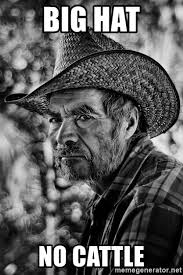 McCoy kind of squirreled around for a couple of seconds, then started looking down at his boots, mumbling expletives, clearing his throat, and finally growled “that’s one of the things I need to talk to you about. I assume Terry Spencer told you about Tim Hepworth’s *#@*%&!!! Beefmaster cows breaking into my stack yard and eating all my hay. Spencer said you’d be helping him on it.”
McCoy kind of squirreled around for a couple of seconds, then started looking down at his boots, mumbling expletives, clearing his throat, and finally growled “that’s one of the things I need to talk to you about. I assume Terry Spencer told you about Tim Hepworth’s *#@*%&!!! Beefmaster cows breaking into my stack yard and eating all my hay. Spencer said you’d be helping him on it.”
I nodded. He made it sound like some kind of robbery; breaking and entering; like 100 head of sneaky cows had broken into his stack yard, built of sturdy pine poles, and eaten over a hundred tons of hay in one sitting. Unlike Spencer, he also made it sound like I was taking a pretty minor, supporting role in the case.
McCoy continued. “Have you ever been around Beefmasters?”
I started to say something, but he cut me off.
“They’re ornery, mean sonsabitches. I’ve been around a lot of cattle, but nothing like these Beefmasters. I’ve been on some of the biggest ranches in California, and they wouldn’t have ‘em. They’re the orneriest cows in the whole world. I’ve never seen anything like ‘em. They can jump like deer, but they’ll run right through a fence. They’ve got Brahma in ‘em you know.”
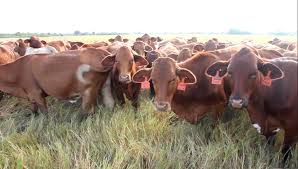
I nodded, and started to try to finish what I started saying before, but he wasn’t finished.
“That Brahma makes ‘em mean that way; like rodeo bulls, you know.”
I continued nodding, having quickly learned that my role in the conversation was apparently limited exclusively to listening.
“You can’t do a damn thing with ‘em. They’re mean as hell. I swear they’d try to attack me, even if I was in my truck, every time I’d go near ‘em. They had me going around afraid for my life. . . . It was worse than living in California. I got so I wouldn’t go near ‘em unless I was in my big tractor, and well armed. They destroyed over $15,000 worth of hay, but they cost me ten times that much in mental and emotional distress. . . . I never had anything like this happen in California. Lived there my whole life, and never had any problems like this. I wanna sue Hepworth for everything he’s got, and I need a lawyer that understands Beefmasters to do it.”
To hear McCoy’s foul-mouthed description of Beefmaster cattle, you’d have thought they were some kind of dangerous, wild monsters. He referred to them as though they were a separate specie. He never referred to them as just cows or cattle, but always as “Beefmasters,” as if the very name of the breed had intrinsic meaning that explained everything.
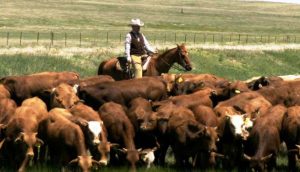 Although I’d been around a few Beefmaster cattle in my travels and growing up, I didn’t know if my background met his definition of “understanding” them. I knew Beefmaster cattle could get a little high-headed, but I also knew several people who raised Beefmaster cattle, which seemed to be fairly well adapted to our local, dry desert ranges, and they seemed to get along just fine with them. In fact, in the local Pioneer Shopper/Nifty Nickel Advertiser, I had recently read two different ads for Beefmaster Bulls in the same issue. They both painted quite a bit different picture than Kenneth McCoy had.
Although I’d been around a few Beefmaster cattle in my travels and growing up, I didn’t know if my background met his definition of “understanding” them. I knew Beefmaster cattle could get a little high-headed, but I also knew several people who raised Beefmaster cattle, which seemed to be fairly well adapted to our local, dry desert ranges, and they seemed to get along just fine with them. In fact, in the local Pioneer Shopper/Nifty Nickel Advertiser, I had recently read two different ads for Beefmaster Bulls in the same issue. They both painted quite a bit different picture than Kenneth McCoy had.
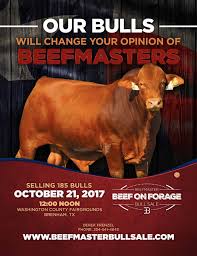 One ad said “excellent purebred Beefmaster Bulls, bred for high fertility, easy calving, fast gaining calves, and excellent dispositions.” The other ad was shorter, but made them sound like outright pets: “Beefmaster Bulls, gentle and intelligent.”
One ad said “excellent purebred Beefmaster Bulls, bred for high fertility, easy calving, fast gaining calves, and excellent dispositions.” The other ad was shorter, but made them sound like outright pets: “Beefmaster Bulls, gentle and intelligent.”
I actually inherited Kenneth McCoy as a client from Terry Spencer. When I opened the Kanab office, I had inherited several Kanab cases from the senior partners, Armstrong and Spencer, and Kenneth McCoy was one of Terry Spencer’s contributions. McCoy had originally gone to Terry, in Cedar City, for help with some estate planning work.
Not long after that, McCoy leased some pasture on his place to Tim Hepworth. Hepworth put a bunch of Beefmaster cattle in the pasture, that McCoy was supposed to tend. Obviously, regardless of what McCoy said, both cattle (Beefmaster or otherwise) and pasture leases were new to him, and he didn’t do a very good job of taking care of either the cattle or the forage (not to mention his haystack). When the feed started getting a little thin in one pasture, and McCoy didn’t bother to rotate the cows into another one, it got to be a lot easier, when those savvy old Beefmaster cows got a little hungry, to just jump the fence into McCoy’s stackyard and graze on his haystack. It was hay that someone else had put up before McCoy  moved onto the place, but he had planned on saving it until the following spring to sell to Navajos, from the nearby reservation, for $8-10 a bale. As time passed, once they got into the habit, the cows just started knocking down the pole fence around the stackyard, and spending most of their time there. Eventually, what hay they didn’t eat, they just tromped, fertilized and mired into the ground, as cows will do when given unlimited access to a stack of hay.
moved onto the place, but he had planned on saving it until the following spring to sell to Navajos, from the nearby reservation, for $8-10 a bale. As time passed, once they got into the habit, the cows just started knocking down the pole fence around the stackyard, and spending most of their time there. Eventually, what hay they didn’t eat, they just tromped, fertilized and mired into the ground, as cows will do when given unlimited access to a stack of hay.
Warm and dry, the sandy stackyard with the remains of a hundred or so tons of tromped and mired hay became a great bed ground for the cows. That, apparently was the basis for Kenneth McCoy’s growing disaffection with cattle.
The next thing Terry Spencer knew, Kenneth McCoy was back to see him about suing Tim Hepworth for destroying his stackyard and eating and/or destroying all his hay, allegedly over a hundred tons, not to mention immeasurable pain and suffering, infliction of emotional distress, and recovery of the attorneys fees incurred to do it.
Although the cows obviously had McCoy buffaloed, and he couldn’t seem to keep them out of his stack yard, I guess he figured a court order might stop them. Unlike me (the team-roping attorney), Terry Spencer was more the golfing, business-lawyer type, maybe not quite as well-versed with Beefmaster cows, pasture lease agreements, and perhaps even ranchers like Kenneth McCoy, so figuring he’d be doing me a favor, Terry agreed to take the case — to pass along to me.
As resident trustee of his mother’s family trust, McCoy had recently bought the Finley Jackson Ranch in Johnson Canyon with money from the trust, supposedly as an investment for his mother, and promptly moved onto the place. It was probably one of the last really good land deals in Johnson Canyon. Although there was a big, nice house on the ranch, Finley Jackson himself had lived in town for years. He had been in financial trouble. The ranch was mortgaged to the hilt with SBA loans that had long since been used to fund Jackson’s various other business enterprises, from construction companies to rock crushers, and he needed money from the sale of the ranch to satisfy his creditors.
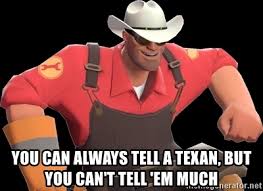 Like many people I’ve known from his home state (and much like Coloradans apparently feel about most Texans), McCoy seemed to know just about everything. He had that unmistakable, smug cock surety that prolonged residence in the Golden State seems to instill in many of its residents. (There are exceptions to every rule, so my apologies and all due respect to some of my good friends and neighbors, who fled California to share this great part of the world with us, and seem to be exceptions to the rule). To listen to McCoy talk, he was an expert on virtually every subject, but particularly (I would come to learn), firearms and wildlife.
Like many people I’ve known from his home state (and much like Coloradans apparently feel about most Texans), McCoy seemed to know just about everything. He had that unmistakable, smug cock surety that prolonged residence in the Golden State seems to instill in many of its residents. (There are exceptions to every rule, so my apologies and all due respect to some of my good friends and neighbors, who fled California to share this great part of the world with us, and seem to be exceptions to the rule). To listen to McCoy talk, he was an expert on virtually every subject, but particularly (I would come to learn), firearms and wildlife.
Although he had been glad to leave California to get away from the crowds, the traffic, the smog, the crime, the violence; out into some clean air and open space, with lots of deer and wildlife, now that he was in Kane County, he had a lot of ideas about how it could be improved to be a whole lot more like where he came from. He had a simple desire, I suppose, for the best of both worlds: the quaint, quiet, peaceful, rural lifestyle of Johnson Canyon, with all the services, amenities and conveniences of Southern California.
He started just about every other sentence with “back in California . . . .”
It didn’t take even Terry Spencer long to get a belly-full of Kenneth McCoy generally, and his language and attitude in particular, so he was very relieved to dump the McCoy/Hepworth cow/hay case, lock, stock and barrel, on me, particularly since I was then manning the Kanab office, and was supposed to have more background with such things.
McCoy told Terry Spencer that he had wondered about just coming to see me about the Hepworth dispute from the outset, but he was concerned that I might be too young and inexperienced, and since he had already been in to see Spencer about the estate planning work, he thought he’d just go that route again. He also wanted to make sure that he had an aggressive, seasoned lawyer working for him. He wanted a fighter.
“Don’t worry about Mac; he’s a fighter,” Terry told McCoy, assuring him that although I’d be helping him with a lot of the leg work, he would continue to manage the case and take it to trial if it came to that. Then, as was often the case in my working relationship with Terry Spencer, that was probably the last time he saw, heard, thought about, or had anything to do with the case.
When Kenneth McCoy stopped by the Kanab office, a short time later, to check on where things stood, even though I had my own opinion of the case and would have typically sided with Hepworth, since Terry had accepted it, thinking it would be right up my alley, I was running with the ball, had things well in hand, and told McCoy where things stood.
McCoy apparently left my office feeling like I wasn’t quite as young and inexperienced as he had assumed. Although the combined effect seemed to leave some people and clients both curious and a little uneasy, my admittedly stocky, 6’2″, 250 pound size, coupled with a mysterious four-inch scar down the left side of my face (the result of a brush with malignant melanoma) seemed to have the remarkable effect of dispelling notions of youthful inexperience, while at the same time instilling images of a fighter. The fact that I was inherently serious, and not naturally endowed with a ready smile also seemed to enhance that image.
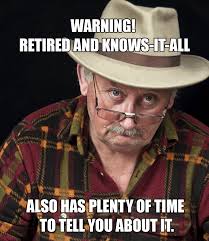 Right from the outset, I got the impression that McCoy was essentially a self-appointed know-it-all, but I was so caught up in a young lawyer’s naive exuberance about having a real important client, a rancher to boot, who, unlike many of my other, financially-challenged clients, made it sound like he was not only made of money, but was also just about the most important person in the world, that I didn’t give much thought to such issues as reasonableness and what it would be like to work with him down the road.
Right from the outset, I got the impression that McCoy was essentially a self-appointed know-it-all, but I was so caught up in a young lawyer’s naive exuberance about having a real important client, a rancher to boot, who, unlike many of my other, financially-challenged clients, made it sound like he was not only made of money, but was also just about the most important person in the world, that I didn’t give much thought to such issues as reasonableness and what it would be like to work with him down the road.
Although I hadn’t even heard the phrase yet, I eventually came to learn that some people (like Chet and Maggie Rawlins) are “legal lightning rods,” and that is definitely how I came to characterize Kenneth McCoy.
In any event, the next time lightning struck, McCoy came straight to me for help.
By contrast, see Real People for Clients
You may also like
-
Omnibus bill provision would “unleash” electronic tracking on nation’s cattle
-
Arizona rancher sues to stop million-acre national monument
-
Bob West: Facing the reality of wolves, Colorado ranchers need to be prepared
-
Protect The Harvest: The whole truth about Western ranching
-
Packing behemoth JBS aims to takeover world’s meat industry

